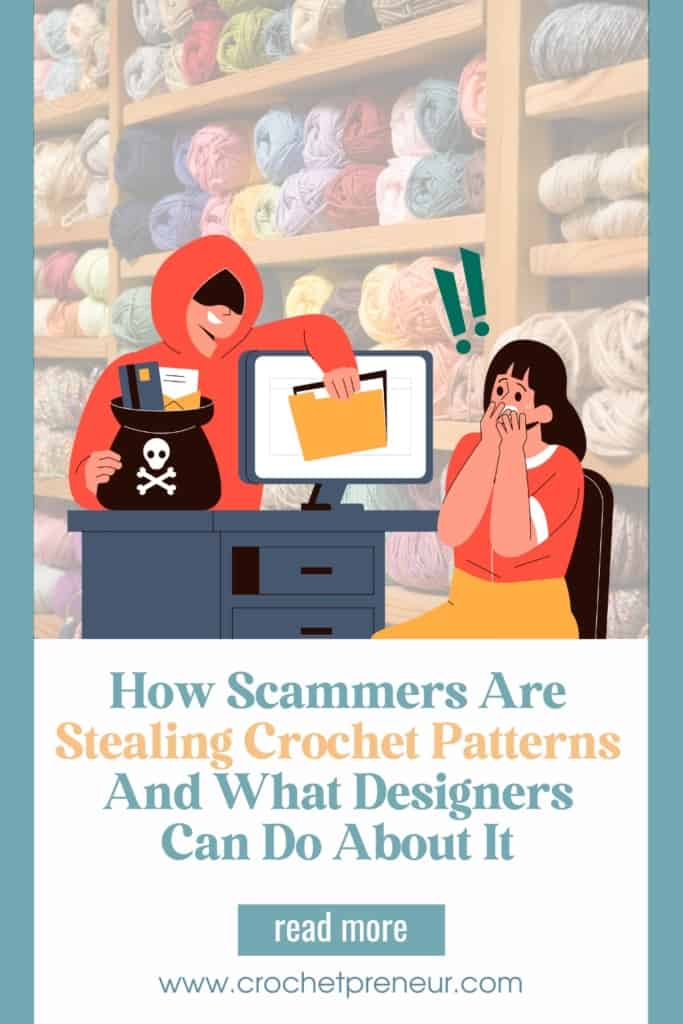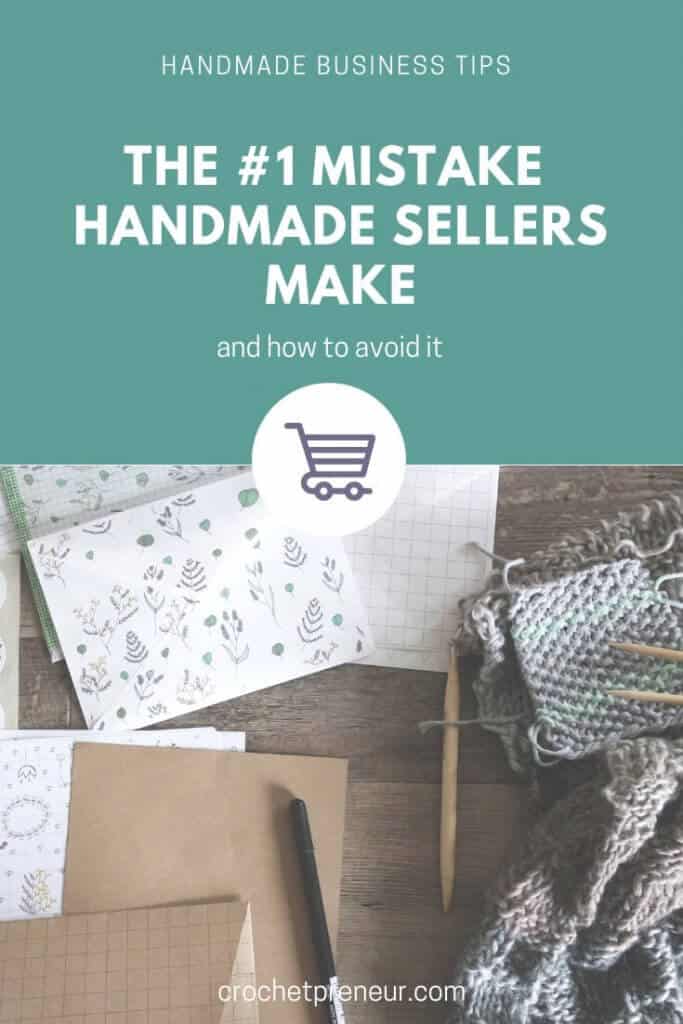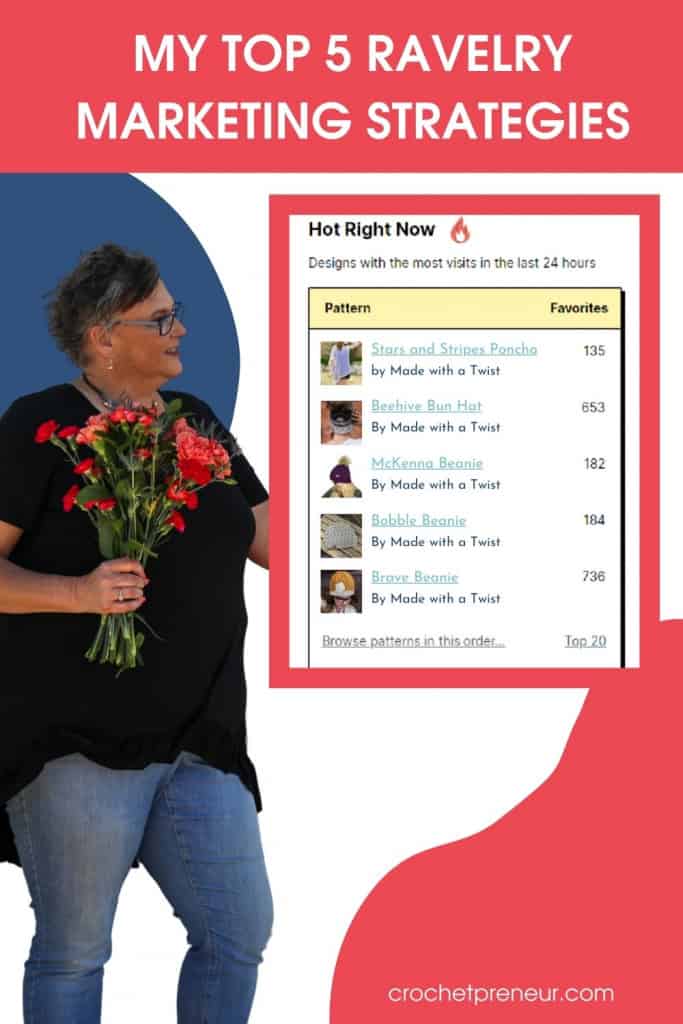A few weeks ago, we addressed the controversy surrounding Elyse Myers and her retro daisy crochet tutorial. My take was that Elyse unintentionally violated social norms in the crochet community. But what about when people intentionally steal your work? Specifically, I’m talking about pattern thieves, scammers, and scrapers. This is becoming a huge problem in the crochet business world. So today, we’re going to talk about what crochet designers can do to mitigate intellectual property theft.
ultimately it’s going to come down to protecting your peace, and controlling what you can control, and letting go of the rest.
– Pamela Grice, the Crochetpreneur

Types of Crochet Pattern Theft
Intellectual property theft in the crochet design world can present in a variety of forms. Here are a few ways that I’ve seen scammers operate, just in the past week:
- Purchasing a pattern (or downloading a free pattern) and then reselling it as their own.
- Purchasing or otherwise accessing a pattern and then putting it up for free on a site created for that purpose.
- Scraping Pinterest pins and adding their own URLs to redirect users to their own site, rather than the original designer’s, to gain ad revenue.
- Taking other people’s crochet patterns, turning them into e-books, and selling them on Amazon.
- Taking crochet patterns and repackaging them, buying Facebook ads, and selling hundreds of thousands of them on Facebook.
This is frustrating and concerning for a crochet business owner. So what can you do about it? Keep reading and listen to the podcast, below. 👇
How Crochet Business Owners Can Combat Intellectual Property Theft and Scams
Legal Protections and Awareness
- Familiarize yourself with copyright laws and how they apply to your crochet patterns (this varies from one country to another).
- Spread the word to other designers and your customers about what a copyright does and does not mean
- For example, include some gentle education in your pattern notes that indicates how the pattern may legally be used.
- Take proactive steps to register your original patterns.
- At very least, establish a clear record of ownership to protect your work. Track your design progress with photos and dates.
- Consider consulting a legal professional to understand your rights and protections.
Embracing Technological Solutions
- Utilize digital watermarks to deter unauthorized use of your patterns and creations. There are apps that can add invisible “watermarks” to the code of your photos and digital files.
- For example, services like SendOwl allow you to embed a custom code in every file.
- Explore the potential of blockchain technology to safeguard your intellectual property.
- Mediavine has a service that requires the user to enter an email address in order to access your free pattern.
Educating Others about Pattern Theft
- Call out pattern theft and scams when you see them (e.g. selling “fake” patterns based on AI-generated crochet images).
- When someone is selling someone else’s design, credit the original designer and link to their pattern.
- Inform, rather than accuse, since it could be something like a bundle sale, where the designer is getting credit and a commission.
- Create blog posts around how to spot stolen content.
- Add a notification on your PDF patterns that indicates who is the original designer and an email address to report pattern theft.
Monitoring and Enforcement
- Implement a system for monitoring online platforms and marketplaces for unauthorized use of your patterns.
- Consider a graduated enforcement approach, including sending cease and desist letters and utilizing takedown procedures.
- Decide how much time and energy you can reasonably invest in monitoring and enforcement while maintaining your mental health.
Beating Pattern Thieves at Their Own Game
- Create appealing targeted ads on platforms like Facebook to promote your authentic patterns and reach your audience directly.
- Sell e-books of your own patterns on Amazon.
- Consider a dedicated business account for pattern sales that sounds a little more “business-like” and a little less “handmade.” Link this account back to your designer page.
Addressing Ethical Considerations around Pattern Use
Selling Completed Products Using Free Patterns
- Understand the ethical boundaries of using free patterns from sources like YouTube to create products for sale.
- Seek permission from pattern designers to sell finished products created from their patterns. In some countries, such as the UK, this is a legal requirement.
Modifying Patterns and Originality
- Recognize the fine line between modifying existing patterns and creating entirely new, original designs. Even if it is not illegal to sell a modified pattern as your own, it is not appreciated in the crochet design industry.
- Uphold ethical standards when considering the rewriting and sale of someone else’s pattern. Just because something is legal doesn’t make it right or doesn’t make it industry standard.
Closing Thoughts
I would love to give you three easy steps to take that would stop people from stealing your patterns. Unfortunately, there is no clear-cut solution to intellectual property theft. It’s important to acknowledge the obstacles associated with pattern theft and take proactive steps to prevent it. But don’t let it become an obsession. Instead, focus on being generous, doing great things in your business, and use the strategies that the thieves use to make your own sales. Be vigilant, protect your own peace, and keep on keeping on, designing gorgeous, beautiful things.
If you found this blog post helpful, be sure to subscribe to the Crochetpreneur podcast for more valuable insights and tips to grow your crochet business!









